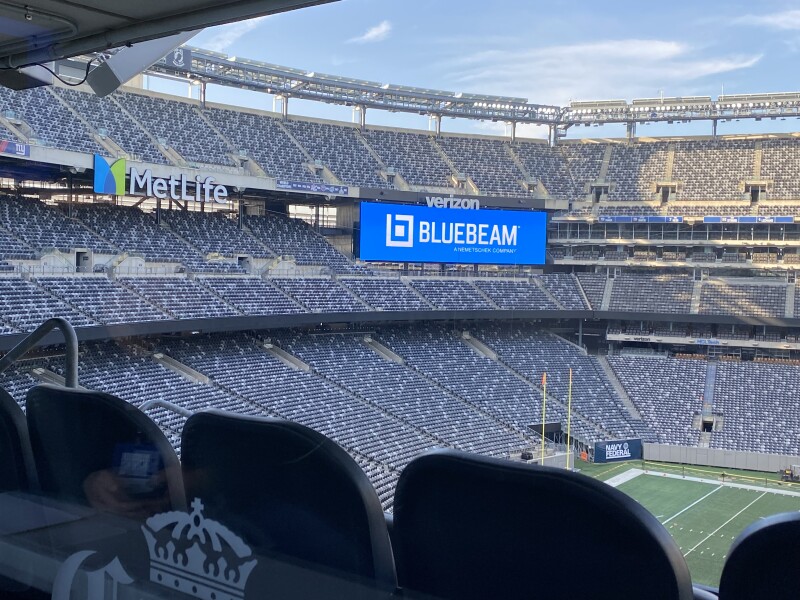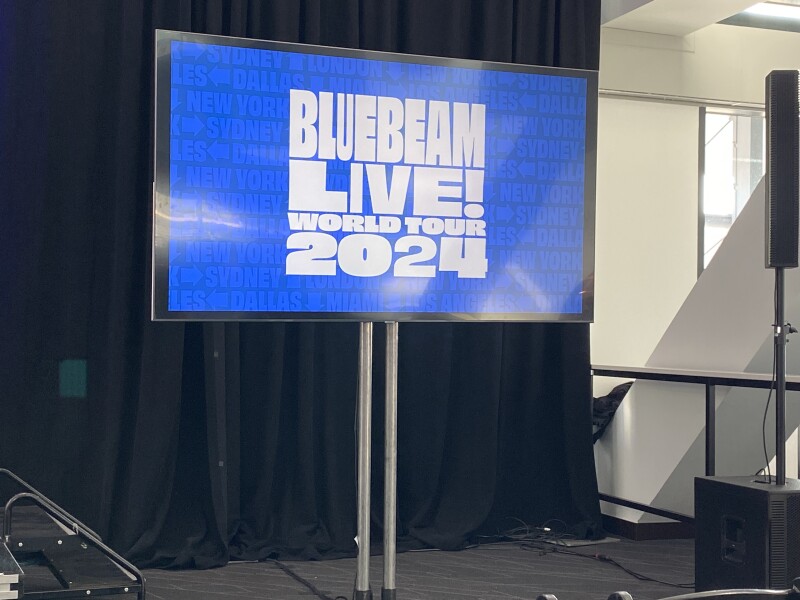Over the last couple of months, Bluebeam has been meeting directly with their customers in a “world tour” they are dubbing Bluebeam Live. Thus far, the software provider focused on bringing paperless workflows to the AEC industry has visited Sydney, Dallas, Miami, Los Angeles, and New York, with a stop in London coming this week to end the tour. Geo Week News went to MetLife Stadium in New Jersey where Bluebeam held their New York stop on the tour, sitting in on the day-long event with Bluebeam customers.
The one-day event featured something for everybody within the Bluebeam customer base, with three tracks of content set up for beginners, advanced users, and executives. The first two tracks included class-like settings for users to gain a deeper knowledge of how to navigate the software based on their existing level of knowledge around Bluebeam. The executive track, which Geo Week News attended, included a pair of roundtable discussions where Bluebeam team members actively sought feedback from those in attendance about what they’re looking for in their workflows and how they’re currently using Bluebeam along with other software options.
In addition to the track content, the event also included presentations from Bluebeam executives talking about some of the new features added to the software along with a roadmap for the future. Those in attendance also saw presentations from local customers, such as the New Jersey Department of Transportation.
Below, find our three big takeaways from spending the day at Metlife Stadium.
Collaboration, in work and with customers.
Collaboration was on display last week in a couple of different ways, both in terms of end users collaborating with other stakeholders on a given project, as well as Bluebeam themselves collaborating with their customers to outline what the future will look like. The former point is fairly straight-forward, as one of the biggest themes throughout my conversations with both Bluebeam team members and the end users in attendance revolved around getting key information into other stakeholders’ hands. Those in attendance were largely well-versed in digital workflows and Bluebeam specifically but they expressed more of a learning curve for some of their colleagues.
One of the big talking points among Bluebeams executives throughout their presentations was the need to get this information in the hands of those in the field in a way that they can use it. This is something Bluebeam CEO Usman Shuja recently wrote about in a guest post with Geo Week News, noting that technology providers are overlooking “their most important users.” He reiterated that point in speaking with Bluebeam Live attendees as well as a private conversation with Geo Week News. There, he expressed a couple of hindrances to bringing field workers more into the digital realm, one around that work largely being distributed among subcontractors as well as the major implications of mistakes.
“The constraints of a job site are real,” Shuja told Geo Week News. “You can’t put an AI system that works 95 percent of the time. It has to work 100 percent of the time, or at least 99.9 percent. If you get the drawing wrong in the office, nothing happens. You get it wrong on the job site, and somebody can die.”
Enabling that better connection between the office and field was a big focus of many of the conversations, but what also stood out was the collaboration between customers and Bluebeam. It was clear right from the outset, for example, that those in attendance were highly-engaged users as one of the first activities of the morning was an enthusiastic crowdsourcing exercise and vote to determine the best keyboard shortcut in the software. Shuja told Geo Week News that the point of bringing back this event in the first place was to bring back an emphasis on customer centricity.
That also came through in the aforementioned roundtables with firm executives. Oftentimes, these kinds of events can feel like pulling teeth in getting a conversation going, but the executives in the room were more than willing to share not only what was working with Bluebeam, but also what they liked from potential Bluebeam competitors and what they’re looking for moving forward. Those two roundtable discussions centered around artificial intelligence and interoperability, which brings us to our other two big takeaways from the day.

Leveraging Artificial Intelligence
It is 2024, so any event is of course going to focus heavily on AI, and this was no exception. During their executive presentations, Bluebeam Chief Innovation Officer Don Jacob outlined some of the newest and upcoming features, which included leveraging AI for things like aligning drawings and other tasks to eliminate tedious pieces of the workflow. In a conversation with Geo Week News, Jacob noted that one of the most important tasks to encourage more AI adoption in the industry is breaking down the differences in types of AI, and not conflating everything with generative AI.
“I think part of what we as an industry need to do is educate the sector around the nuance of AI,” he said. “We know a paint brush versus a roller. With AI, there are differences, and I think a lot of the trepidation is because of that.”
That is certainly part of it, and executives talked about some of the other issues they have around AI adoption for their firms specifically as well. Largely, those concerns came down to two main categories: Security and accuracy. For security, it’s straight forward as no firm wants to risk having sensitive data leaked. For some in the room who work for government agencies, they expressed that they couldn’t use any type of AI product at this point because of data concerns. Additionally, there was concern around hallucinations – the act of a large-language model like ChatGPT confidently spitting out inaccurate information – and the knock-on effects that could have on the rest of a workflow.
Shuja, meanwhile, told Geo Week News that AI can be helpful, but it needs to be the right tool. Some of that could be done with generative AI like LLMs, some with more machine learning and computer vision workflows, and some perhaps without AI at all.
“My philosophy has been, AI is a tool to solve a problem. My guidance to the team is, let’s solve customer problems. If it happens to be better done with AI, then let’s do it with AI, and we’re doing that with different techniques.”
Embracing Interoperability
If you talk to those in the construction industry today that work in the office, one of the biggest complaints you’re bound to hear is frustration around needing so many separate applications and solutions to complete an entire workflow. This is a natural point on the process for the industry’s digitalization, as the sector went from not having the right solutions to having offerings addressing specific issues. Now, however, there are too many disparate solutions, and the course is starting to correct between acquisitions and interoperability connections.
To that end, Bluebeam focused a lot on APIs to connect parts of their software with other softwares and allow for better interoperability between systems in the industry. This was also a topic of discussion on the executive track in the second roundtable of the day. There, executives told Bluebeam team members what they are looking for in their workflows, which largely revolved around easily transferring key data points between systems and between stakeholders.
While Bluebeam, along with the rest of the industry, is embracing this interoperability in a big way right now, it’s always been part of their ethos. Their software, as Shuja points out, is based around an open standard in PDF, and they are part of an international consortium around the PDF standard. Jacob told Geo Week News that it’s important for Bluebeam to recognize their role in the AEC sector, and making sure they’re doing the best thing for the space.
“The curse and the blessing is, now we’ve got all these tools to be able to make large sets of data very easily. Now, how do we make sense of it all? No one system creates all that data, so being able to orient, relate, and connect that is the next natural stumbling block - or opportunity, however you look at it. At Bluebeam, we recognize we have a part to play in that from a collaboration aspect. Information is getting added to the project, and we see a responsibility. How do we be a good partner for the customer and for the industry?”







